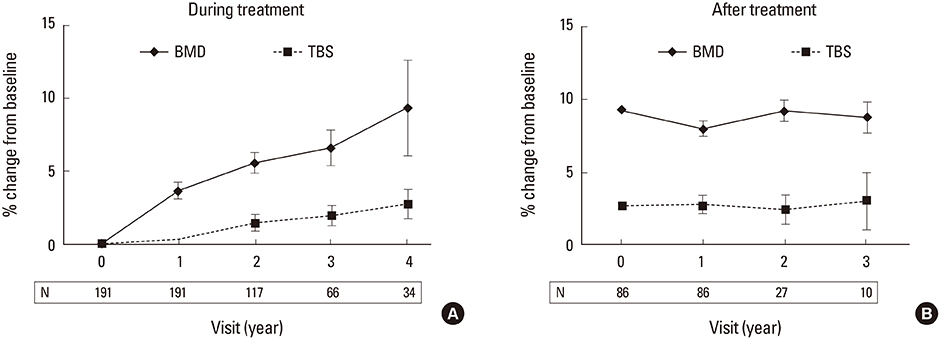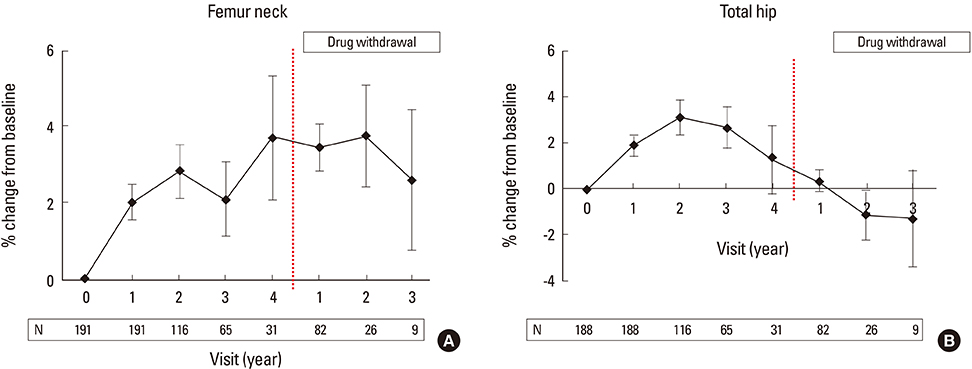J Bone Metab.
2017 May;24(2):117-124. 10.11005/jbm.2017.24.2.117.
Longitudinal Change in Trabecular Bone Score during and after Treatment of Osteoporosis in Postmenopausal Korean Women
- Affiliations
-
- 1Division of Endocrinology and Metabolism, Department of Internal Medicine, Hanil General Hospital, Seoul, Korea.
- 2Division of Endocrinology and Metabolism, Department of Internal Medicine, School of Medicine, Kangwon National University, Chuncheon, Korea.
- 3Department of Internal Medicine, Wonkwang University Sanbon Hospital, Gunpo, Korea. hykimmd@hanmail.net
- KMID: 2379994
- DOI: http://doi.org/10.11005/jbm.2017.24.2.117
Abstract
- BACKGROUND
The aim of this study was to evaluate the longitudinal changes of trabecular bone score (TBS) during and after bisphosphonate (BP) treatment in postmenopausal Korean women with osteoporosis.
METHODS
We analyzed 191 patients who took BP and underwent bone mineral density (BMD) test for the period from January 2010 to December 2015. The mean follow up period during treatment and after treatment was 22.8 months and 18 months, respectively. The TBS and BMD values were evaluated by the percent changes relative to the baseline.
RESULTS
In 191 patients, who treated with BPs, L-spine BMD increased 3.65±0.5% and TBS increased 0.26±0.4% from baseline during first 1 year. At 2 to 4 years, the changes of BMD and TBS from baseline gradually increased up to 9.3±3.25% and 2.69±0.98% and both results showed statistically significant correlation. In 86 patients who stopped BPs, L-spine BMD decreased -0.54±1.07% and TBS increased 0.33±1.96% from baseline during 3 years follow up period.
CONCLUSIONS
Lumbar spine TBS increase over time with BPs treatment although the changes were less than that of BMD. Also, it preserve for years after stopping treatment, as the changes of lumbar spine BMD. The results of BMD and TBS showed significant correlation during treatment but not during drug withdrawal.
Figure
Reference
-
1. NIH Consensus Development Panel on Osteoporosis Prevention, Diagnosis, and Therapy. Osteoporosis prevention, diagnosis, and therapy. JAMA. 2001; 285:785–795.2. van der Meulen MC, Jepsen KJ, Mikić B. Understanding bone strength: size isn't everything. Bone. 2001; 29:101–104.
Article3. Johnell O, Kanis JA, Oden A, et al. Predictive value of BMD for hip and other fractures. J Bone Miner Res. 2005; 20:1185–1194.
Article4. Cummings SR, Bates D, Black DM. Clinical use of bone densitometry: scientific review. JAMA. 2002; 288:1889–1897.5. Miller PD, Siris ES, Barrett-Connor E, et al. Prediction of fracture risk in postmenopausal white women with peripheral bone densitometry: evidence from the National Osteoporosis Risk Assessment. J Bone Miner Res. 2002; 17:2222–2230.
Article6. Pasco JA, Seeman E, Henry MJ, et al. The population burden of fractures originates in women with osteopenia, not osteoporosis. Osteoporos Int. 2006; 17:1404–1409.
Article7. WHO Study Group. Assessment of fracture risk and its application to screening for postmenopausal osteoporosis. Report of a WHO Study Group. World Health Organ Tech Rep Ser. 1994; 843:1–129.8. Chen P, Miller PD, Delmas PD, et al. Change in lumbar spine BMD and vertebral fracture risk reduction in teriparatide-treated postmenopausal women with osteoporosis. J Bone Miner Res. 2006; 21:1785–1790.
Article9. Sarkar S, Mitlak BH, Wong M, et al. Relationships between bone mineral density and incident vertebral fracture risk with raloxifene therapy. J Bone Miner Res. 2002; 17:1–10.
Article10. Seeman E, Delmas PD. Bone quality-the material and structural basis of bone strength and fragility. N Engl J Med. 2006; 354:2250–2261.
Article11. Silva BC, Leslie WD, Resch H, et al. Trabecular bone score: a noninvasive analytical method based upon the DXA image. J Bone Miner Res. 2014; 29:518–530.
Article12. Hans D, Goertzen AL, Krieg MA, et al. Bone microarchitecture assessed by TBS predicts osteoporotic fractures independent of bone density: the Manitoba study. J Bone Miner Res. 2011; 26:2762–2769.
Article13. Briot K, Paternotte S, Kolta S, et al. Added value of trabecular bone score to bone mineral density for prediction of osteoporotic fractures in postmenopausal women: the OPUS study. Bone. 2013; 57:232–236.
Article14. Krueger D, Fidler E, Libber J, et al. Spine trabecular bone score subsequent to bone mineral density improves fracture discrimination in women. J Clin Densitom. 2014; 17:60–65.
Article15. Krieg MA, Aubry-Rozier B, Hans D, et al. Effects of anti-resorptive agents on trabecular bone score (TBS) in older women. Osteoporos Int. 2013; 24:1073–1078.
Article16. Dufresne TE, Chmielewski PA, Manhart MD, et al. Risedronate preserves bone architecture in early postmenopausal women in 1 year as measured by three-dimensional microcomputed tomography. Calcif Tissue Int. 2003; 73:423–432.
Article17. Popp AW, Guler S, Lamy O, et al. Effects of zoledronate versus placebo on spine bone mineral density and microarchitecture assessed by the trabecular bone score in postmenopausal women with osteoporosis: a three-year study. J Bone Miner Res. 2013; 28:449–454.
Article18. Senn C, Günther B, Popp AW, et al. Comparative effects of teriparatide and ibandronate on spine bone mineral density (BMD) and microarchitecture (TBS) in postmenopausal women with osteoporosis: a 2-year open-label study. Osteoporos Int. 2014; 25:1945–1951.
Article19. Korean Endocrine Society. Osteoporosis fact sheet 2014. 2014. cited by 2016 December 1. Available from: http://www.endocrinology.or.kr/image/main/kor_Osteoporosis_Fact_Sheet2014.pdf.20. Eastell R, Walsh JS, Watts NB, et al. Bisphosphonates for postmenopausal osteoporosis. Bone. 2011; 49:82–88.
Article21. Russell RG, Watts NB, Ebetino FH, et al. Mechanisms of action of bisphosphonates: similarities and differences and their potential influence on clinical efficacy. Osteoporos Int. 2008; 19:733–759.
Article22. Eastell R, Hannon RA, Wenderoth D, et al. Effect of stopping risedronate after long-term treatment on bone turnover. J Clin Endocrinol Metab. 2011; 96:3367–3373.
Article23. Gedmintas L, Solomon DH, Kim SC. Bisphosphonates and risk of subtrochanteric, femoral shaft, and atypical femur fracture: a systematic review and meta-analysis. J Bone Miner Res. 2013; 28:1729–1737.
Article24. Imai K, Ohnishi I, Matsumoto T, et al. Assessment of vertebral fracture risk and therapeutic effects of alendronate in postmenopausal women using a quantitative computed tomography-based nonlinear finite element method. Osteoporos Int. 2009; 20:801–810.
Article25. Burghardt AJ, Kazakia GJ, Sode M, et al. A longitudinal HR-pQCT study of alendronate treatment in postmenopausal women with low bone density: Relations among density, cortical and trabecular microarchitecture, biomechanics, and bone turnover. J Bone Miner Res. 2010; 25:2558–2571.
Article26. Winzenrieth R, Michelet F, Hans D. Three-dimensional (3D) microarchitecture correlations with 2D projection image gray-level variations assessed by trabecular bone score using high-resolution computed tomographic acquisitions: effects of resolution and noise. J Clin Densitom. 2013; 16:287–296.
Article27. Di Gregorio S, Del Rio L, Rodriguez-Tolra J, et al. Comparison between different bone treatments on areal bone mineral density (aBMD) and bone microarchitectural texture as assessed by the trabecular bone score (TBS). Bone. 2015; 75:138–143.
Article28. Rizzoli R, Chapurlat RD, Laroche JM, et al. Effects of strontium ranelate and alendronate on bone microstructure in women with osteoporosis. Results of a 2-year study. Osteoporos Int. 2012; 23:305–315.
Article29. Black DM, Schwartz AV, Ensrud KE, et al. Effects of continuing or stopping alendronate after 5 years of treatment: the Fracture Intervention Trial Long-term Extension (FLEX): a randomized trial. JAMA. 2006; 296:2927–2938.
Article30. Black DM, Reid IR, Cauley JA, et al. The effect of 6 versus 9 years of zoledronic acid treatment in osteoporosis: a randomized second extension to the HORIZON-Pivotal Fracture Trial (PFT). J Bone Miner Res. 2015; 30:934–944.
Article31. Neele SJ, Evertz R, De Valk-De Roo G, et al. Effect of 1 year of discontinuation of raloxifene or estrogen therapy on bone mineral density after 5 years of treatment in healthy postmenopausal women. Bone. 2002; 30:599–603.
Article32. Bone HG, Bolognese MA, Yuen CK, et al. Effects of denosumab treatment and discontinuation on bone mineral density and bone turnover markers in postmenopausal women with low bone mass. J Clin Endocrinol Metab. 2011; 96:972–980.
Article33. Kalder M, Hans D, Kyvernitakis I, et al. Effects of exemestane and tamoxifen treatment on bone texture analysis assessed by TBS in comparison with bone mineral density assessed by DXA in women with breast cancer. J Clin Densitom. 2014; 17:66–71.
Article
- Full Text Links
- Actions
-
Cited
- CITED
-
- Close
- Share
- Similar articles
-
- Associations between bone mineral density, trabecular bone score, and body mass index in postmenopausal females
- Comparison of Denosumab and Zoledronic Acid in Postmenopausal Women With Osteoporosis: Bone Mineral Density (BMD) and Trabecular Bone Score (TBS)
- Trabecular Bone Score as a Risk Factor of Major Osteoporotic Fracture in Postmenopausal Women: The First Study in Thailand
- Effect of Romosozumab on Trabecular Bone Score Compared to Anti-Resorptive Agents in Postmenopausal Women with Osteoporosis
- Trabecular bone score as an additional therapeutic decision tool in osteoporosis and osteopenia



